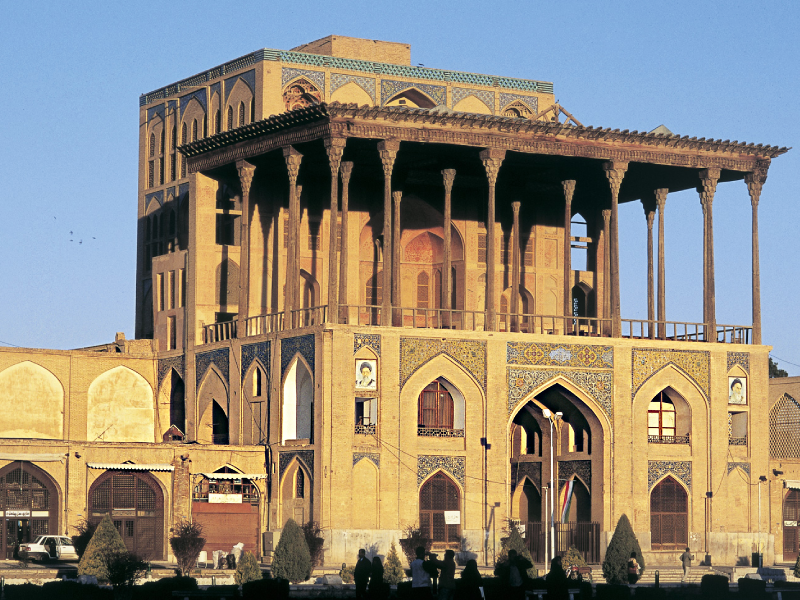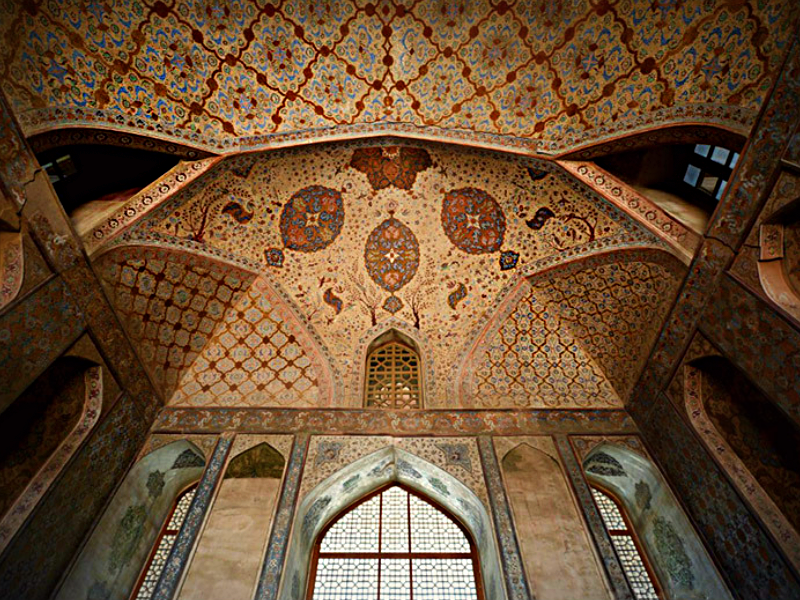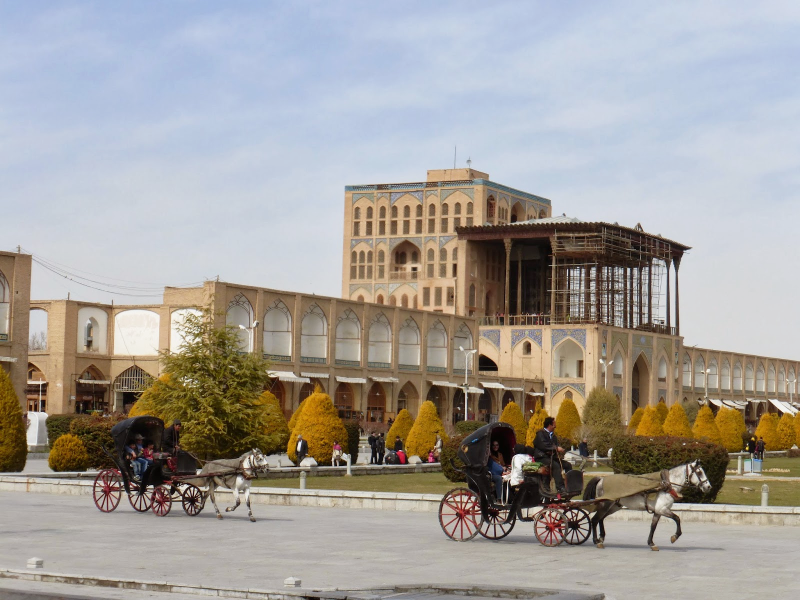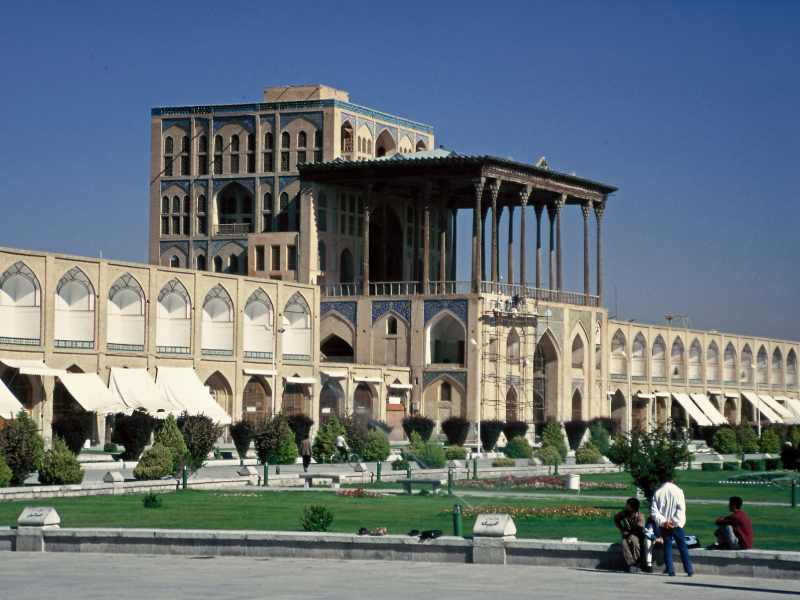Ali Qapu Palace, Isfahan (Photos, History, Architecture)
The Ali Qapu Palace, or Kakh-e Ali Qapu, is an architectural marvel that stands tall and proud in the heart of Isfahan, Iran. This magnificent Isfahan palace, with its intricate architectural design and rich historical significance, has captured the imagination of visitors for centuries. From its commanding position on the western side of Naghshe Jahan Square, Ali Qapu has witnessed the rise and fall of empires and served as a symbol of power, artistic excellence, and cultural heritage. Let us delve into the fascinating history and architectural splendor of this Persian masterpiece.
Ali Qapu Architecture
The palace is known for its distinctive architecture, which combines elements of Persian and Islamic design. It rises six stories tall and features a large central dome that provides panoramic city views. The facade is adorned with intricate tilework, calligraphy, and colorful frescoes depicting scenes from Persian mythology and historical events.
One of the most notable features of the Aali Qapu is the famous “peacock throne” located on the fifth floor. This ornate throne was made of solid gold and was adorned with precious gemstones and intricate carvings. Unfortunately, the original throne was looted during the Afghan invasion of Iran in the early 18th century, and only a replica remains today.
The Ali Qapu Palace is also known for its beautiful gardens and courtyards, which provide a peaceful retreat from the bustling city outside. The gardens are adorned with fountains, pools, and lush vegetation, creating a serene and picturesque ambiance.
Ali Qapu Palace Interior
Inside Ali Qapu Palace, visitors are transported to a world of lavish interiors and artistic brilliance. The palace walls are covered with exquisite frescoes depicting scenes of courtly life, hunting expeditions, and mythological tales. These frescoes, executed by renowned Safavid artists, are a testament to the high level of artistic talent nurtured under Shah Abbas I.
Another highlight of the palace is the magnificent wooden balcony that overlooks Naqsh-e Jahan Square. The balcony, known as the “Talar-e Aali Qapu,” offers a breathtaking panoramic view of the square and its surroundings. The wooden columns supporting the balcony are masterfully carved, displaying intricate floral and geometric patterns.
Persian Historical Music Room
Within the Ali Qapu Palace complex, various rooms and halls were used for different purposes during the Safavid dynasty, including music performances and gatherings. The palace served as the main residence of the Shahs of Iran and was a center of art, culture, and entertainment.
The palace’s Music Hall, located on the upper floor of Ali Qapu, was a prominent space for music performances. This hall was known for its exceptional acoustics, which allowed the sounds of Persian classical music to resonate beautifully. Musicians and vocalists would entertain the royal court and guests with performances of traditional Persian music, creating a captivating atmosphere.
Ali Qapu Palace Functionality
Beyond its architectural grandeur, Ali Qapu Palace was designed with practicality in mind. Administrative offices, reception halls, and the Shah’s private quarters are found on the lower levels of the palace. The upper floors were dedicated to entertainment and leisure activities. The palace’s strategic location allowed the Shah and his court to observe the festivities and processions taking place in the square.
Throughout its history, Ali Qapu Palace has witnessed significant events and ceremonies. The Safavid Shahs, as well as subsequent rulers, utilized the palace as a venue for state functions, banquets, and public audiences. It served as a hub of political and cultural activities, attracting scholars, poets, and artists who gathered to showcase their talents in the presence of the royal court.
Why was the Ali Qapu Palace Important?
The Ali Qapu Palace is important for several reasons:
Political importance: The palace was the main residence of the Safavid monarchs in Isfahan. It served as the seat of power and the administrative center of the Safavid Empire.
Architectural significance: The Ali Qapu Palace is renowned for its stunning architecture and intricate design. It is considered a masterpiece of Persian architecture, showcasing the skills and craftsmanship of the Safavid era.
Cultural importance: The palace played a significant role in Safavid court life and culture. It was the venue for various cultural activities such as music concerts, poetry readings, and theatrical performances.
Historical significance: The Ali Qapu Palace witnessed significant historical events during the Safavid period. It was where Shah Abbas I received important guests, negotiated treaties and held royal receptions.
Imperial Gate in Isfahan
The Naqsh-e Jahan Square Gate, or Imperial Gate, is a grand entrance adorned with intricate tile work, calligraphy, and decorative motifs. It served as a symbol of power and prestige and welcomed important visitors and dignitaries to the royal court. The gate’s design reflects the Safavid era’s architectural style and Persian craftsmanship’s artistic excellence.
When was the Ali Qapu Palace Built?
The Ali Qapu Palace was built during the late 16th century, specifically during the reign of Shah Abbas I of the Safavid dynasty. The construction of the palace began around 1592 and was completed around 1598. It was designed as a residential palace for the Shah and his royal court and served as a center of political, cultural, and artistic activities during the Safavid era.
How Big is the Ali Qapu Palace?
Ali Qapu Palace is a six-story structure with an estimated height of around 38 meters (125 feet) and has a rectangular plan with an area of 1800 square meters (5905 feet). The palace’s size and scale, along with its impressive wooden balcony and music hall, contribute to its commanding presence within Naqsh-e Jahan Square.
What was Ali Qapu Palace Used for?
Ali Qapu Palace served multiple purposes during its history. It was primarily used as a residential palace for the Safavid rulers, including Shah Abbas I and his royal court. The lower levels of the palace housed administrative offices where state affairs were conducted. It was also a venue for hosting banquets, public audiences, and cultural events, including music performances. Additionally, the palace served as a center for political activities, where diplomatic encounters with foreign dignitaries took place. Aali Qapu Palace was a symbol of power, a center of administration, and a hub of cultural and entertainment activities during the Safavid era.
Preservation and Tourism
Over the centuries, Aali Qapu Palace faced periods of neglect and deterioration. However, extensive restoration efforts have been undertaken to preserve this architectural gem and its historical significance. Today, the palace stands proudly as a UNESCO World Heritage Site, drawing visitors from all corners of the globe.
Tourists visiting Aali Qapu Palace are captivated by its timeless beauty and the stories it holds within its walls. Exploring the palace’s various levels, visitors can immerse themselves in the grandeur of Safavid-era Iran, gaining insights into the cultural and artistic achievements of the time.
Ali Qapu Location
Aali Qapu Palace is located in Isfahan, Iran. Specifically, it is situated on the western side of Naqsh-e Jahan Square, which is one of the largest squares in the world and a UNESCO World Heritage Site (Location on map). Naqsh-e Jahan Square is in the center of Isfahan and is surrounded by several other notable historical landmarks, including the Imam Mosque (Shah Mosque), Sheikh Lotfollah Mosque, and the Isfahan Grand Bazaar. The central location of Aali Qapu Palace within this architectural ensemble makes it easily accessible and a focal point for visitors exploring the city’s rich cultural heritage.
Best Time to Visit Ali Qapu Palce
The best time to visit Ali Qapu Palace is during the spring (April to June) and autumn (September to November) seasons. During these months, the weather in Isfahan, Iran, where the palace is located, is mild and pleasant, with temperatures ranging from comfortable to slightly warm. In this way, exploring the palace’s interior and wandering around Naqsh-e Jahan Square becomes more enjoyable.
It’s worth noting that the summer months (June to August) can be quite hot in Isfahan, with temperatures reaching high levels, which might make outdoor activities and sightseeing less comfortable. Winter (December to February) can bring cold temperatures, and there is a possibility of rain or even snow. However, visiting during the winter months can offer a unique and quieter experience, as there are fewer tourists around.
Ali Qapu Entrance Fee
Aali Qapu ticket price is 2,500,000 Iranian Rials (approximately USD 4) for non-Iranian tourists. However, It is recommended to check with local authorities, tourist information centers, or official websites for the most up-to-date information regarding the entrance fee for Ali Qapu Palace.
Aali Qapu Timing Information
Opening hours: The palace is open to visitors in spring and summer from 9 am to 6 pm and in autumn and winter from 9 am to 4 pm.
Closed days: Ali Qapu Palace is open every day except for Taswa and Ashura, the death of the Prophet (PBUH), the martyrdom of Imam Jafar Sadiq (AS), the martyrdom of Hazrat Ali (AS) and the death of Imam Khomeini (RA).
However, It’s always better to double-check the current opening hours and any potential closures before your visit. You can verify the most up-to-date information by contacting local authorities, and tourist information centers, or checking official websites associated with Ali Qapu Palace or the tourism department of Isfahan.
More information to visit Aali Qapu Palace
Aali Qapu Contact Number: +983132225958
Recommended duration of visit: 1 to 2 hours.
Aali Qapu Address: Iran, Isfahan City, Ostandari St., Sepeh St., Naqsh-e Jahan Square, Isfahan, Ali Qapu Palace.
Final Word
The Aali Qapu Palace stands as a testament to the architectural brilliance and cultural heritage of Iran. Its imposing presence on Naqsh-e Jahan Square, in addition to its intricate designs and historical significance, make it a must-visit destination for travelers and history enthusiasts. As a result of combining Persian and Islamic architectural styles, the palace’s magnificent interiors transport visitors to a bygone era of richness and artistic excellence. Aali Qapu Palace is a living testament to the rich and storied history of Iran and continues to inspire awe and wonder in all who have the privilege of experiencing its grandeur.
Are you planning to travel to Iran and Looking for an Iran travel agency? Please read Things to do in Isfahan and Check out our Iran tours.










Leave a Reply
Want to join the discussion?Feel free to contribute!